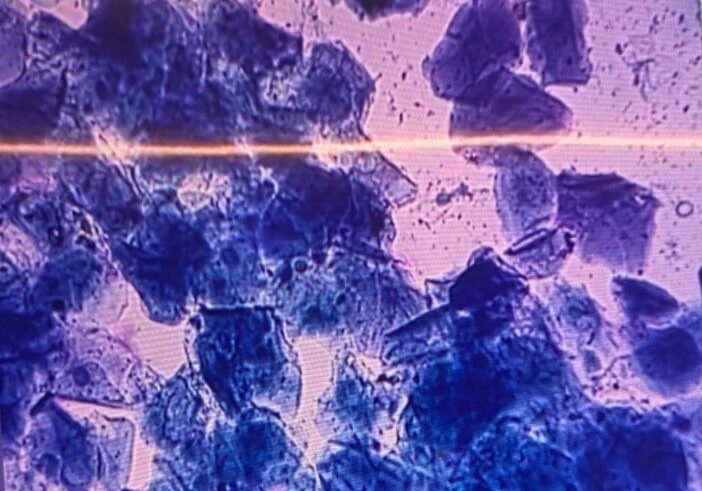Pre-Breeding Exams
Before breeding your dog, a pre-breeding exam is recommended to assess their health and reproductive readiness. Dr. Sam advises a yearly breeding soundness exam to check for disease, infertility, and to establish a baseline for future breeding. Testing may include Brucellosis, LH, progesterone, thyroid, CBC, genetic panels, OFA radiographs, and semen evaluations—performed either in-house or sent to IDEXX. These results help guide informed breeding decisions and create a customized breeding plan.
Breeding Soundness Exam
After reviewing your dog’s history—including diet, vaccines, medications, breeding history, and overall health—Dr. Sam performs a physical exam. This includes a vaginal or prostate check for abnormalities, along with an evaluation of the respiratory, cardiovascular, and musculoskeletal systems to confirm your dog is healthy and fit for breeding or pregnancy.

Testing
Brucellosis (IDEXX)
To protect the health of all breeding patients, a current negative Brucellosis test (within six months) is required. This bacterial infection can spread between dogs, affecting the reproductive organs and potentially causing infertility, pregnancy loss, joint pain, and lameness.
CBC Profile (in-house)
A complete blood count can be run to rule out any systemic issues that could affect breeding and a biochemical profile can be run to make sure all organs are functioning properly before breeding.
Thyroid Panel (in-house)
Thyroid levels can affect the tissues of the uterus, fallopian tubes and ovaries. It can sometimes lead to miscarriage. We have in-house machines that we can get the results within about 20 minutes!
LH Testing (In-House/IDEXX)
Thyroid levels can affect the tissues of the uterus, fallopian tubes and ovaries. It can sometimes lead to miscarriage. We have in-house machines that we can get the results within about 20 minutes!
OFA Radiographs (in-house)
We perform many OFA examinations and radiographs for hips/elbows etc. and send them to The Orthopedic Foundation of America for evaluation and screening for hereditary defects.
Vaginal cytology
and vaginoscopy
Vaginal cytology is performed on female dogs during their estrus cycle to help determine the optimum time to breed and enhance the success of pregnancy. Vaginoscopy can be performed to assess the vestibule, vagina and cervix. It helps to verify if the female is ready to be bred in the future.
Progesterone Testing (In-house: IDEXX or TOSOH AIA-360)
Accurately tracking your dog’s estrus cycle is essential for planning optimal breeding times.
Semen Collection & Evaluation
A collection and evaluation can be performed on a stud dog’s semen to ensure the sample is viable for breeding
Culture/Cytology:
A culture can be performed to investigate if there are any infectious diseases in the reproductive system. Vaginal Cytology is the microscopic examination of the vaginal epithelial cells. It is used to determine the stages of the canine estrous cycle.
Inseminations

*Vaginal cytology of a dog in oestrus
Vaginal Insemination
This type of insemination is usually performed with fresh or chilled semen. A MAVIC vaginal insemination catheter is inserted and a balloon inflates which simulates the “natural tie” during a live breeding. This causes uterine contractions which pushes the semen to the oviducts and prevents backflow. Because this method deposits semen near the cervix but not inside the cervix. It is not recommended to use frozen semen with this method.
Transcervical Insemination (TCI)
This type of insemination is performed using a TCI scope that delivers the semen directly through the cervix into the uterus. This is a highly advantageous method because of where the sperm is deposited inside the cervix. This method can be used with fresh, chilled or frozen semen.
Surgical Insemination
This method is performed under general anesthesia. An abdominal incision is made and semen is deposited into both uterine horns. This method can be used with all types of semen. It is the recommended method when using frozen semen, semen with unknown quality and for females that have been previously infertile. Progesterone is very important with this type of insemination to ensure the success of a breeding and to maximize conception and litter size. This method is also suggested when the progesterone number is very high or near the end of ovulation.
Semen Collection
Semen collection from your stud is important for several reasons. The first reason is to evaluate the quality of the semen. After your stud is collected, we will first evaluate the semen for its concentration using the sperm-rich fraction of the ejaculate. Using the International Canine Semen Bank’s methods we can evaluate the concentration,motility,progressive motility and morphology of a sperm sample. Another reason to obtain a semen sample through collection is to use the sample for a planned artificial insemination. A semen collection can also be kept in long term storage utilizing ICSB’s freezing process.
Semen Evaluation
After collection, we evaluate the semen. Applying ICSB’s procedures we assess the motility, concentration and morphology of the sample. For fertilization to occur the sperm need to be able to swim to the egg. The results of the analysis of motility tells us the percentage of sperm that are moving and how quickly they are moving. These are different types of motilities:
Progressive Motility: This type of motility is when sperm swim in a linear way or in large circles.
Non-Progressive Motility: This type of motility is when sperm are moving but not in a straight line or are moving in tight circles.
Immotile: The sperm has no movement at all.
Concentration
Next, we assess sperm concentration and morphology. Concentration refers to the number of sperm cells per milliliter, which varies by breed but must be sufficient for fertilization. Morphology evaluates the size, shape, and structure of the sperm. Abnormalities—such as bent, coiled, or detached sperm—can impact fertility. Low motility, low concentration, or abnormal morphology may point to reproductive or health concerns that warrant further evaluation.
Semen Collection
Frozen Semen
At All Pets, we offer semen freezing and long-term storage services. Samples—either fresh or chilled—are evaluated for suitability, processed with protective media, and frozen into pellets. A post-thaw test ensures quality before storing the sample in liquid nitrogen tanks, where it can remain viable for decades. We accept and ship frozen semen both domestically and internationally. Depending on sample quality, each collection may yield one or multiple breeding units, which can be thawed for insemination at our facility or sent to another clinic as requested.
Chilled Semen
When using chilled semen, a stud dog is collected, the semen is cooled down and an extender is added to the sample. By utilizing an ICSB Puppy Pak, this sample can be packaged safely and shipped overnight. Fresh semen will generally live for up to 4 days once inseminated. When using chilled semen it is important to note that the sperm cells live from 24 to 48 hours once it is inseminated. At All Pets, we can package the collected sample for shipment or our PuppyPak’s can be sold to our clients for use at home.
Partner with All Pets for Successful Breedings
Our team is committed to excellence in canine reproduction, combining cutting-edge techniques with compassionate care. Whether you’re navigating breeding, managing pregnancy, or preserving your dog’s semen for future use, we’re here to guide you every step of the way.
Contact us today at (908) 707-1555 to schedule a consultation and let us help you achieve a healthy, successful breeding, from insemination to whelping!
For more information please see icsbnj.com.
